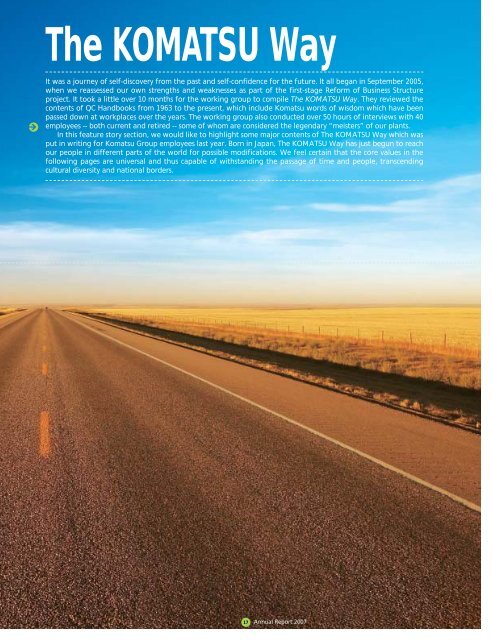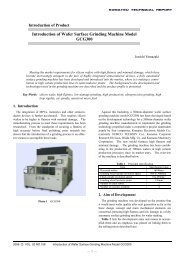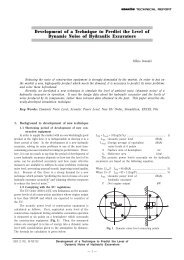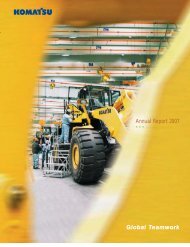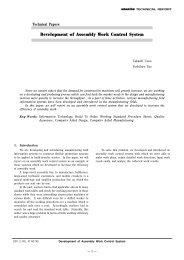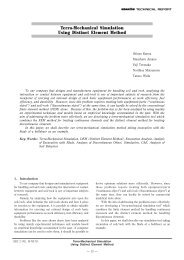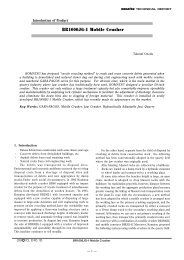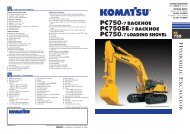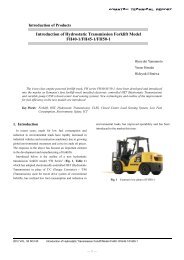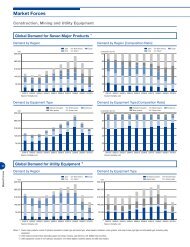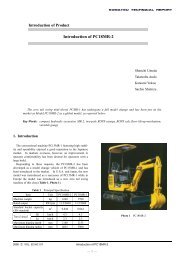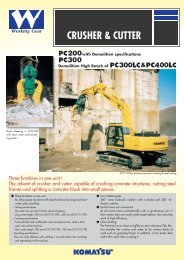Feature Section : The Komatsu Way
Feature Section : The Komatsu Way
Feature Section : The Komatsu Way
You also want an ePaper? Increase the reach of your titles
YUMPU automatically turns print PDFs into web optimized ePapers that Google loves.
<strong>The</strong> KOMATSU <strong>Way</strong><br />
It was a journey of self-discovery from the past and self-confidence for the future. It all began in September 2005,<br />
when we reassessed our own strengths and weaknesses as part of the first-stage Reform of Business Structure<br />
project. It took a little over 10 months for the working group to compile <strong>The</strong> KOMATSU <strong>Way</strong>. <strong>The</strong>y reviewed the<br />
contents of QC Handbooks from 1963 to the present, which include <strong>Komatsu</strong> words of wisdom which have been<br />
passed down at workplaces over the years. <strong>The</strong> working group also conducted over 50 hours of interviews with 40<br />
employees -- both current and retired -- some of whom are considered the legendary “meisters” of our plants.<br />
In this feature story section, we would like to highlight some major contents of <strong>The</strong> KOMATSU <strong>Way</strong> which was<br />
put in writing for <strong>Komatsu</strong> Group employees last year. Born in Japan, <strong>The</strong> KOMATSU <strong>Way</strong> has just begun to reach<br />
our people in different parts of the world for possible modifications. We feel certain that the core values in the<br />
following pages are universal and thus capable of withstanding the passage of time and people, transcending<br />
cultural diversity and national borders.<br />
17 Annual Report 2007
<strong>Feature</strong> <strong>Section</strong><br />
What is <strong>The</strong><br />
KOMATSU <strong>Way</strong>?<br />
Background: Building the spirit of challenge<br />
When <strong>Komatsu</strong> was established in 1921,<br />
Meitaro Takeuchi, founder, spelled out his<br />
founding principles as “Globalization,”<br />
“Quality First,” “Technology Innovation,”<br />
and “Human Resource Development.” Just<br />
like many other companies operating<br />
Meitaro Takeuchi around the world today, we’ve come a long<br />
way with ups and downs in our history of<br />
86 years. Just to mention a few, our forerunners met a series of<br />
critical challenges –-- post-war recovery and building a business<br />
from scratch in 1946, complete deregulation of the Japanese<br />
construction equipment market in January 1964, which opened<br />
to foreign competition, and the Plaza Accord of 1985 which<br />
caused an 8.5% appreciation of the Japanese yen within a<br />
mere 24 hours of announcement of the Accord, at a time when<br />
our export sales accounted for about 54% of total sales.<br />
While many people in Japan were talking about how many<br />
weeks or months at most it would take for <strong>Komatsu</strong> to go<br />
under due to the market liberalization, our forerunners were<br />
busy round the clock developing and introducing bulldozers<br />
with dramatic improvements in quality. To the great surprise of<br />
the Japanese people, however, the forerunners not only made<br />
the Company stronger by taking on the international challenge,<br />
but also demonstrated and embedded those founding<br />
principles as our corporate DNA. <strong>The</strong> KOMATSU <strong>Way</strong> is built<br />
on <strong>Komatsu</strong>’s strengths which are substantiated by the beliefs,<br />
patterns of behavior and know-how that our forerunners<br />
learned from their experiences of both success and failure of<br />
the past, and it is our corporate DNA that we would like all<br />
employees of the <strong>Komatsu</strong> Group around the world to keep<br />
throughout the passage of time.<br />
Today, just for the construction and mining equipment,<br />
we generate about 80% of total sales away from Japan,<br />
about half of our workforce represents non-Japanese citizens,<br />
and we operate 33 manufacturing facilities in 16 countries,<br />
outside of Japan. Now that <strong>The</strong> KOMATSU <strong>Way</strong> is available in<br />
printed form, we have a tool for sharing our corporate DNA<br />
with all <strong>Komatsu</strong> Group people working around the world.<br />
<strong>The</strong> KOMATSU <strong>Way</strong>: Defining the values for all <strong>Komatsu</strong> employees<br />
around the world<br />
<strong>The</strong> cornerstone of our management lies in commitment to<br />
Quality and Reliability in order to maximize our corporate value.<br />
We define our corporate value as the total sum of trust given to<br />
us by all our stakeholders and society. To improve this trust, we<br />
<strong>Komatsu</strong>‘s Sales and Overseas Expansion<br />
Foreign Exchange Rate (JPY/USD)<br />
Yen<br />
360<br />
260<br />
Fixed Rate System Floating Exchange<br />
160<br />
(USD1=JPY360) Rate System<br />
60<br />
<strong>Komatsu</strong>’s Business Results<br />
Billions of yen<br />
2,000<br />
Consolidated Net Sales<br />
1,500<br />
Export (non-consolidated)<br />
1,000<br />
Sales in Japan (non-consolidated)<br />
Ratio of Export (non-consolidated)<br />
500<br />
Plaza Accord<br />
Stabilization of Exchange Rates<br />
%<br />
80<br />
60<br />
40<br />
20<br />
0<br />
’60<br />
’61<br />
’62<br />
’63<br />
’64<br />
’65<br />
’66<br />
’67<br />
’68<br />
’69<br />
’70<br />
’71<br />
’72<br />
’73<br />
’74<br />
’75<br />
’76<br />
’77<br />
’78<br />
’79<br />
’80<br />
’81<br />
’82<br />
’83<br />
’84<br />
’85<br />
’86<br />
’87<br />
’88<br />
’89<br />
’90<br />
’91<br />
’92<br />
’93<br />
’94<br />
’95<br />
’96<br />
’97<br />
’98<br />
’99<br />
’00<br />
’01<br />
’02<br />
’03<br />
’04<br />
’05<br />
’06<br />
Rapid Growth of Japanese Economy Expansion of Exports Expansion of Overseas Production Globally Consolidated Management<br />
0<br />
New Production Bases<br />
Established Abroad<br />
(1) Coping with restrictions<br />
from nationalization<br />
policy in target countries<br />
A total of 44 plants are now in operation.<br />
(11 plants in Japan and 33 overseas)<br />
• Brazil (1972) • Mexico (1974) • Indonesia (1982)<br />
(2) Local production in Europe<br />
and USA<br />
• UK (1985) • Italy (1991) • Germany (1989, 1996)<br />
• USA (1985, 1994, 2002)<br />
(3) Entry to Emerging Market • China (1995) : 3 Plants<br />
• Thailand (1995) • India (1998, 2007)<br />
18 Annual Report 2007
<strong>The</strong> KOMATSU <strong>Way</strong><br />
Corporate Governance<br />
Five Principles<br />
1. Vitalize the functions of the board of directors.<br />
2. Take the initiative in communicating with all<br />
our stakeholders.<br />
3. Comply with the rules of the business<br />
community.<br />
4. Never put off responses to risks.<br />
5. Keep thinking about your successor.<br />
MONOZUKURI<br />
Collaboration<br />
with Business<br />
Partners<br />
Policy<br />
Deployment<br />
Human Resource<br />
Development<br />
Seven <strong>Way</strong>s<br />
of KOMATSU<br />
Workplace<br />
(Genba)<br />
Philosophy<br />
Commitment<br />
to Quality and<br />
Reliability<br />
Defining the<br />
Root Cause<br />
Customer<br />
Oriented<br />
have consistently worked to strengthen our corporate governance<br />
and Monozukuri or manufacturing competitiveness. Such efforts<br />
have transformed into the source of <strong>Komatsu</strong>’s strengths,<br />
becoming two core components of <strong>The</strong> KOMATSU <strong>Way</strong>.<br />
When we speak about Monozukuri at <strong>Komatsu</strong>, we mean<br />
not only plant floors but rather all value-chain activities in which<br />
we are engaged -- in the spirit of teamwork -- by suppliers and<br />
distributors in addition to internal operations ranging from<br />
development, production, sales and service to administration. In<br />
<strong>The</strong> KOMATSU <strong>Way</strong>, we have identified the seven core values<br />
that support our Monozukuri.<br />
1) Commitment to Quality and Reliability:<br />
Quality is our top-priority commitment, and thus we will<br />
never make any compromise on quality.<br />
2) Customer Oriented:<br />
By valuing the opinions of our customers, we continue to<br />
offer the products and services that they are proud to own.<br />
3) Defining the Root Cause:<br />
By clearly defining all processes from product planning to<br />
machine conditions in the field, we always work to find<br />
and fix the root cause of problems in order to prevent the<br />
problem from recurring.<br />
4) Workplace Philosophy:<br />
Workplaces (Genba in Japanese) offer information which<br />
should constitute the foundation of our policies, strategies,<br />
improvement plans and other vital initiatives. It’s important to<br />
emphasize and look at the facts of workplaces, making<br />
information “visible.”<br />
5) Policy Deployment:<br />
As soon as top management policies are announced,<br />
employees on all levels understand their respective roles,<br />
make their own activity plans, and implement them on<br />
their initiative.<br />
6) Collaboration with Business Partners:<br />
In all operations from development to sales and after-sales<br />
service, we work together with our business partners from<br />
around the world to solve problems and improve<br />
operations, share know-how and work for our mutual<br />
growth as “One <strong>Komatsu</strong>.”<br />
7) Human Resource Development:<br />
It is the human resources, i.e., employees, that support<br />
sustainable corporate growth. Employees are the most<br />
valuable corporate asset and thus human resource<br />
development and educational programs for employees are<br />
indispensable worldwide.<br />
To ensure <strong>The</strong> KOMATSU <strong>Way</strong> is established throughout the<br />
<strong>Komatsu</strong> Group worldwide, we formed KOMATSU <strong>Way</strong> Division<br />
in July 2006. Since then it has conducted a number of<br />
promotional and educational activities, including 56<br />
presentations by Kunio Noji, Director (currently President and<br />
CEO). In the following pages, we would like to introduce our<br />
human resource development efforts, one of the seven ways of<br />
<strong>Komatsu</strong>, and some programs that have been put in place over<br />
the years as well as more recently.<br />
19 Annual Report 2007
<strong>Feature</strong> <strong>Section</strong><br />
Human Resource<br />
Development<br />
Programs<br />
All-<strong>Komatsu</strong> QC Convention: Sharing innovative ideas to improve<br />
workplace capabilities<br />
KOMATSU <strong>Way</strong> Division hosted the 38th annual All-<strong>Komatsu</strong><br />
QC Convention on November 18, 2006. Held at our Oyama<br />
Plant and its nextdoor neighbor, <strong>Komatsu</strong> Forklift’s (currently,<br />
KOMATSU Utility Co., Ltd.’s) Tochigi Plant, it accommodated a<br />
total of 72 groups, including 16 from abroad and eight from<br />
suppliers, which made presentations covering a diverse range of<br />
QC activities on the plant floor and in staff and administration<br />
operations. Highlights of this Convention were two groups from<br />
the United Kingdom and China winning first place. <strong>Komatsu</strong><br />
UK’s Production Improvements Team presented close-knit<br />
teamwork activities by its assembly and manufacturing<br />
engineering people. <strong>Komatsu</strong> Shantui Construction Machinery’s<br />
Production Management Team introduced its activities which<br />
have improved supply-chain management by means of directly<br />
linking distributors and plants.<br />
All-<strong>Komatsu</strong> Technology Olympics: Showcasing individual engineering expertise<br />
Third Saturday of October every year is designated as<br />
<strong>Komatsu</strong>’s Skills Day. <strong>The</strong> Production Division and Human<br />
Resources Department jointly held the 29th annual All-<br />
<strong>Komatsu</strong> Technology Olympics at the Mooka and Osaka<br />
plants from October 19 to 21, 2006. A total of 120 engineers,<br />
including 29 from abroad and 11 from suppliers, participated<br />
in the competitive events of machining, welding, assembly,<br />
painting, parts inspection and mechatronics maintenance.<br />
Highlights of the 2006 Olympics include Miyuki Miyamura<br />
All-<strong>Komatsu</strong> Technology Olympics<br />
from the Awazu Plant winning first place in the parts<br />
inspection event, the first female champion in the history of<br />
this competition, and Chen Yu from <strong>Komatsu</strong> Shantui<br />
Construction Machinery in China, coming in second place for<br />
the welding event and Stephen Boal from <strong>Komatsu</strong> UK in<br />
England, receiving third place in the painting event.<br />
Global Training Institute: Sharing <strong>Komatsu</strong> ways of supporting<br />
customers’ work<br />
Our Product Support Division offers the Global Training Institute<br />
(GTI), a 12 to 13-week, comprehensive product support<br />
program, every year to facilitate the growth of candidates for<br />
key managerial positions of local product support operations at<br />
our overseas subsidiaries and distributors. With 120 subjects in<br />
the curriculum, the GTI emphasizes the strategy of the product<br />
lifecycle business and the concept of win-win-win (customersdistributors-<strong>Komatsu</strong><br />
as manufacturer) relationship.<br />
Held in Japan, Europe and the United States from October<br />
17, 2006 to February 23, 2007, the third GTI was participated<br />
in by 13 selected employees from eight <strong>Komatsu</strong> Group<br />
companies, including <strong>Komatsu</strong> Ltd. in Japan, and one from PT<br />
United Tractors Tbk, our Indonesian distributor. To date, a<br />
total of 38 persons, including four from our distributors,<br />
representing 11 countries, have completed the GTI.<br />
Global Management Seminar: Sharing the values that<br />
<strong>Komatsu</strong> stand by<br />
Following the previous fiscal year, our Human Resources<br />
Department in the Tokyo Head Office sponsored the second<br />
Global Management Seminar in Tokyo from April 11 through<br />
14, 2007. A total of 13 presidents and senior managers from<br />
11 subsidiaries in seven countries attended the seminar, where<br />
senior officers of <strong>Komatsu</strong> Ltd. made presentations concerning<br />
<strong>Komatsu</strong>’s strategies for management, globalization, R&D,<br />
production and so forth. This seminar also included the<br />
presentations on <strong>The</strong> KOMATSU <strong>Way</strong> by Masahiro Sakane,<br />
president and CEO (currently Chairman of the Board) as well as<br />
the general manager of KOMATSU <strong>Way</strong> Division. It’s an urgent<br />
task for all of us in the <strong>Komatsu</strong> Group now to share the same<br />
values so that we will be able to drive our efforts in the same<br />
direction, as we continue to grow overseas in the spirit of<br />
global teamwork.<br />
20 Annual Report 2007
Brian Kober,<br />
Vice President,<br />
Corporate Planning and Strategy,<br />
<strong>Komatsu</strong> America Corp.<br />
“I was most impressed to learn that <strong>The</strong> KOMATSU <strong>Way</strong> has<br />
been distilled from the entire history of <strong>Komatsu</strong>. Each of the<br />
seven elements of <strong>The</strong> KOMATSU <strong>Way</strong> came about from the<br />
reaction of the company to real threats or challenges over its<br />
86-year history.<br />
“In my current role as head of Corporate Planning and<br />
Strategy, the concepts and tools around policy deployment<br />
make it the one of the seven ways that relates to me most in<br />
my workplace today. <strong>Komatsu</strong> persevered through its<br />
challenges of the past by directly and clearly communicating<br />
its priorities to each member of the workforce.<br />
“<strong>The</strong> exciting thing is that <strong>The</strong> KOMATSU <strong>Way</strong> is fluid and<br />
alive. It is an unfinished work, and so serves as a great<br />
framework for where to start when you are facing a new<br />
problem, but leaves the ultimate solution, and extension of<br />
the principles up to the creativity of the team.”<br />
Jorge Hosokawa,<br />
Director, Manufacturing,<br />
<strong>Komatsu</strong> do Brasil Ltda.<br />
“Even though I translated the contents of <strong>The</strong> KOMATSU <strong>Way</strong><br />
into Portuguese and gave the translation to all managers at<br />
<strong>Komatsu</strong> do Brasil in March 2007, I have deepened my<br />
understanding of <strong>The</strong> KOMATSU <strong>Way</strong> in this seminar. Most<br />
notably, I was impressed when Mr. Noji encouraged us to<br />
promote <strong>The</strong> KOMATSU <strong>Way</strong> to meet our needs. I am sure that<br />
all other participants felt the same.<br />
“Without any doubt, all the seven ways are essential to<br />
strengthen our operation in Brazil, mainly because we are the global<br />
supply base of D41 and D51 bulldozers for the <strong>Komatsu</strong> Group. We<br />
need to improve more and reinforce our jobs through <strong>The</strong><br />
KOMATSU <strong>Way</strong>. I am sure that the seven ways are highly valued<br />
tools and concepts, not only for the Company but also for the<br />
professional growth of each one of us. It is the level of our workers’<br />
knowledge, skills and professionalism that ensures the quality of our<br />
products. That’s my job to maintain and upgrade their level.”<br />
Mike Blom,<br />
Deputy Managing Director,<br />
<strong>Komatsu</strong> Southern Africa (Pty) Ltd.<br />
“I have worked for the company for 26 years. In my previous<br />
visits to our Japanese operations, especially at plants, I<br />
remember that <strong>The</strong> KOMATSU <strong>Way</strong> has always been there,<br />
maybe not in written form or stated policy, but ingrained in<br />
the behavior of its employees. This has not been the way for<br />
many overseas operations.<br />
“<strong>The</strong> most critical aspect of <strong>The</strong> KOMATSU <strong>Way</strong> is the fact<br />
that <strong>Komatsu</strong> executive management in Japan has proactively<br />
taken steps to engender the philosophy of <strong>The</strong> KOMATSU<br />
<strong>Way</strong> to all its international operations. At <strong>Komatsu</strong> Southern<br />
Africa, the process of disseminating it has begun already and<br />
will continue in various phases during the course of the year.<br />
At present, we need to emphasize the human resource<br />
development and workplace (Genba) philosophy in our<br />
operation. <strong>The</strong> major competitive advantage we can create<br />
over our competitors will be through our people. <strong>The</strong><br />
KOMATSU <strong>Way</strong> is the best tool for this urgent need.<br />
“This is the first time I have been involved in the deep<br />
understanding on how <strong>Komatsu</strong> does<br />
things and I am excited and proud to be<br />
part of it.”<br />
Hubert Bruening,<br />
General Manager, Working Gear Division,<br />
<strong>Komatsu</strong> Hanomag GmbH<br />
“I believe “Commitment to Quality and Reliability” of the<br />
seven ways reflects the core of <strong>Komatsu</strong>. As a matter of fact,<br />
during the Global Management Seminar, I “found” this<br />
management policy to be the major reason that I feel proud<br />
to work for <strong>Komatsu</strong>.<br />
“<strong>The</strong> KOMATSU <strong>Way</strong> means a tool for me. During this<br />
seminar, I realized its importance as it gives answers to why<br />
we are proud to work for <strong>Komatsu</strong>, why <strong>Komatsu</strong> is<br />
successful, and why we do things in the company as they are<br />
done. It is <strong>The</strong> KOMATSU <strong>Way</strong> that sharpens the positive<br />
<strong>Komatsu</strong> aspects and ensures that we run the same way in<br />
the same direction with the highest efficiency.<br />
“I would like to mention that it has been impressive to see<br />
how top management gives flexibility to each region of the<br />
world, to each company of the <strong>Komatsu</strong> family, to each<br />
manager – how to implement <strong>The</strong> KOMATSU <strong>Way</strong> without<br />
leaving any doubt about <strong>The</strong> KOMATSU <strong>Way</strong> itself.”<br />
21 Annual Report 2007
<strong>Feature</strong> <strong>Section</strong><br />
<strong>The</strong> KOMATSU <strong>Way</strong><br />
in Practice<br />
Accomplishing Successful Production Start-up of the PC200-8<br />
Hydraulic Excavator around the World<br />
As we have globalized our operation, it has become more<br />
important for us to manufacture our products with uniformity in<br />
product quality for customers around the world. Most recently,<br />
in response to Tier 3 emission standards for diesel engines in<br />
North America and Europe. Effective since January 2006, our<br />
plants in Japan, the United States, Europe and Thailand mounted<br />
our in-house developed “ecot3” Tier 3-compliant engines on 21<br />
models, including the new PC200-8 hydraulic excavator. We<br />
would like to show how our people at our U.S. and Thai plants<br />
worked to accomplish production start-up of our global standard<br />
excavator model as simultaneously as possible with the Osaka<br />
Plant, their Mother plant.<br />
for overall logistics and parts inventory. Five team members<br />
traveled to Japan to take part in the start-up production for<br />
three of the models of hydraulic excavators at the Osaka Plant.<br />
<strong>The</strong> special team created the master schedule for each<br />
department’s activities and required dates of completion. From<br />
May through September, they met monthly as a total group,<br />
and weekly in October for the assembly line-on scheduled for<br />
November 7, 2005. For the PC200LC-8, the team still met<br />
weekly until the end of November by when all issues had been<br />
thoroughly discussed for solutions. Each department had its<br />
own meetings to discuss the schedule and activities it was<br />
responsible for. <strong>The</strong> department leader was responsible for<br />
updating the master schedule with his/her department’s<br />
activities and reporting it in the team meetings. CMO’s Mother<br />
Plant – Osaka – made sure to send all <strong>Komatsu</strong> Technical<br />
Information on-time to allow CMO to meet its schedule.<br />
A sense of urgency was in the air. All employees knew that<br />
they could afford to make no mistake since they only had a<br />
lead-time of five months for six models, including one aftermodel<br />
change. To ensure trouble-free production, they created<br />
an individualized list for all parts for the warehousing operation<br />
which was being outsourced by CMO. In this way they were<br />
able to achieve the correct and in-time delivery of parts to<br />
assembly work centers on the plant floor.<br />
PC200-8 hydraulic excavator<br />
Chattanooga Manufacturing Operation in the United States:<br />
Demonstrating policy deployment capabilities<br />
<strong>Komatsu</strong> America Corp.’s Chattanooga Manufacturing<br />
Operation (CMO) produces five models of hydraulic excavators,<br />
ranging from 20 to 40 tons, and three models of articulated<br />
dump trucks. To ensure smooth launchings of Tier 3-compliant<br />
models, including the PC200LC-8 updated hydraulic excavator,<br />
they formed a special, cross-functional team in April 2005. <strong>The</strong><br />
team consisted of people from design engineering, production<br />
planning, procurement, cost management, manufacturing<br />
engineering, manufacturing, quality assurance and warehouse<br />
departments. Jay Fuchita, senior manager of design<br />
engineering, was the team leader responsible for overall<br />
schedule status checks, and Bruce Nelson, senior manager of<br />
manufacturing administration, was the sub leader responsible<br />
Assembly line at CMO<br />
22 Annual Report 2007
Bruce Nelson<br />
Senior Manager, Manufacturing Administration<br />
Chattanooga Manufacturing Operation<br />
<strong>Komatsu</strong> America Corp.<br />
“We actually had no major problem because everyone<br />
communicated very well with each other and we all made sure to<br />
help each department so that all necessary activities were carried<br />
out on time. We also ensured that actual assembly went well by<br />
having a special team follow the first time production through<br />
the entire manufacturing process and record the problems as<br />
they occurred. <strong>The</strong> team met weekly after production start-up to<br />
correct any problems found in the manufacturing process and<br />
we solved all problems within three weeks.”<br />
Bangkok <strong>Komatsu</strong> Co., Ltd.<br />
product discussed in the meetings.<br />
At BKC, communication is one of the most important key<br />
words in all activities. Thus, the First Product Meeting program<br />
is considered to be a perfect tool to enhance communication in<br />
order to achieve the target of production start-up.<br />
Hirun Huntrakul<br />
Quality Assurance Manager<br />
Bangkok <strong>Komatsu</strong> Co., Ltd.<br />
Bangkok <strong>Komatsu</strong>: Making commitments to Quality and Reliability<br />
Bangkok <strong>Komatsu</strong> Co., Ltd. (BKC) is positioned as an exclusive<br />
production base of the <strong>Komatsu</strong> Group for PC200 hydraulic<br />
excavators. Having survived the currency crisis of July 1997,<br />
BKC exports about 80% of its total production volume of<br />
3,200 units, mainly to North America and Greater Asia, today.<br />
As soon as BKC received <strong>Komatsu</strong> Technical Information<br />
concerning the PC200-8 model from its Mother Plant in Osaka<br />
in June 2005, BKC started holding its original First Product<br />
Meeting program for suppliers to share technical information<br />
concerning the parts and establish goals with them on an<br />
individual basis. BKC first introduced this program in 2001 for<br />
the production start-up of the PC200-7 model, because they<br />
discovered many technical problems in locally made parts. <strong>The</strong><br />
meetings with suppliers are held under the leadership of the<br />
Purchase Department and joined by the Quality Assurance<br />
Department before actual purchase of the parts. In typical<br />
meetings, the Purchase Department uses about 30% of the<br />
time to discuss purchase-related matters, such as delivery and<br />
costs, with suppliers, while the Quality Assurance Department<br />
uses about 70%, for technical issues. <strong>The</strong>re are also three<br />
quality specialists, two specializing in parts and one in<br />
machine performance, who have received training at the<br />
Osaka Plant. <strong>The</strong>y play the important roles of arranging and<br />
monitoring frequency of the meetings, and reviewing the item<br />
coverage ratio, which is the percentage of parts for each<br />
“Our successful start-up for the PC200-8 model lies<br />
significantly with the First Product Meeting. For the PC200-8,<br />
we reviewed 819 items with about 40 suppliers individually,<br />
which translates into an item coverage ratio of 85%,<br />
compared to 60% for PC200-7 in 2001. For most items, we<br />
had one or two meetings, but for difficult items, such as dies<br />
and molds for the production of door cover assembly and<br />
engine hoods, we had eight to ten meetings at maximum. To<br />
solve the problems, we also had a good support from the<br />
Mother Plant. I realize that this meeting program is not easy,<br />
but I would like to take a strong leadership in driving this kind<br />
of activities to make BKC the best quality factory in the world.”<br />
23 Annual Report 2007


